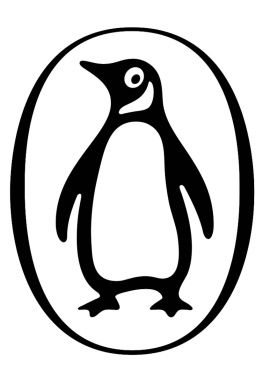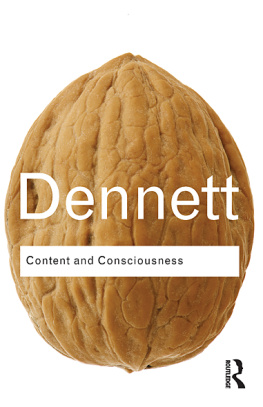PENGUIN BOOKS
CONSCIOUSNESS EXPLAINED
A fabulous book buy it today and give your Joycean machine a treat Andy Clark in The Times Higher Education Supplement
Dennetts central weapons are evolutionary biology and the computer model of the mind. He uses evolution to understand the explosion in brain complexity over the last three million years of human history, and computer theory to explain how our culturally conditioned thought-patterns might be embodied in a cortex whose structure is biologically fixed a masterly expositor, the Stephen Jay Gould of the cognitive sciences David Papineau in the Independent on Sunday
His sophisticated discourse is as savvy and articulate about good beer or the Boston Celtics as it is about parallel processing, modern cognitive experimentation, neuropathology, echolocation by bats, or Ludwig Wittgenstein He does all this with verve in a persuasive philosophical work, the best examined in this column for decades Scientific American
Consciousness Explained has perhaps the most arrogant title of any book in this or any other year, and proceeds to justify that arrogance by doing precisely what it claims Roz Kaveney in City Limits
An attractive tour through the science and philosophy of consciousness, a splendid dissolving of the supposed problems that functionalist accounts of consciousness are held to have Tim Shallice in Nature
ABOUT THE AUTHOR
Daniel C. Dennett is Distinguished Professor of Arts and Sciences and Director of the Center for Cognitive Studies at Tufts University in Massachusetts. He is the author of Content and Consciousness (1969); Brainstorms (1978); Elbow Room (1984); The Intentional Stance (1987); Consciousness Explained (1992; Penguin, 1993); the highly acclaimed Darwins Dangerous Idea (1995; Penguin, 1996); Kinds of Minds (1996); and Brainchildren (Penguin, 1998).
PENGUIN BOOKS
Published by the Penguin Group
Penguin Books Ltd, 80 Strand, London WC2R 0RL, England
Penguin Putnam Inc., 375 Hudson Street, New York, New York 10014, USA
Penguin Books Australia Ltd, 250 Camberwell Road, Camberwell, Victoria 3124, Australia
Penguin Books Canada Ltd, 10 Alcorn Avenue, Toronto, Ontario, Canada M4V 3B2
Penguin Books India (P) Ltd, 11 Community Centre, Panchsheel Park, New Delhi 110 017, India
Penguin Books (NZ) Ltd, Cnr Rosedale and Airborne Roads, Albany, Auckland, New Zealand
Penguin Books (South Africa) (Pty) Ltd, 24 Sturdee Avenue, Rosebank 2196, South Africa
Penguin Books Ltd, Registered Offices: 80 Strand, London WC2R 0RL, England
www.penguin.com
First published in the USA by Little, Brown & Company 1991
First published in Great Britain by Viking 1992
Published in Penguin Books 1993
Copyright Daniel C. Dennett, 1991
All rights reserved
The moral right of the author has been asserted
constitutes an extension of this copyright page
Except in the United States of America, this book is sold subject to the condition that it shall not, by way of trade or otherwise, be lent, re-sold, hired out, or otherwise circulated without the publishers prior consent in any form of binding or cover other than that in which it is published and without a similar condition including this condition being imposed on the subsequent purchaser
ISBN: 978-0-14-195610-7
DANIEL C. DENNETT
CONSCIOUSNESS EXPLAINED
ILLUSTRATED BY PAUL WEINER

PENGUIN BOOKS
For Nick, Marcel, and Ray
CONTENTS
)
)
PREFACE
My first year in college, I read Descartess Meditations and was hooked on the mind-body problem. Now here was a mystery. How on earth could my thoughts and feelings fit in the same world with the nerve cells and molecules that made up my brain? Now, after thirty years of thinking, talking, and writing about this mystery, I think Ive made some progress. I think I can sketch an outline of the solution, a theory of consciousness that gives answers (or shows how to find the answers) to the questions that have been just as baffling to philosophers and scientists as to laypeople. Ive had a lot of help. Its been my good fortune to be taught, informally, indefatigably, and imperturbably, by some wonderful thinkers, whom you will meet in these pages. For the story I have to tell is not one of solitary cogitation but of an odyssey through many fields, and the solutions to the puzzles are inextricably woven into a fabric of dialogue and disagreement, where we often learn more from bold mistakes than from cautious equivocation. Im sure there are still plenty of mistakes in the theory I will offer here, and I hope they are bold ones, for then they will provoke better answers by others.
The ideas in this book have been hammered into shape over many years, but the writing was begun in January 1990 and finished just a year later, thanks to the generosity of several fine institutions and the help of many friends, students, and colleagues. The Zentrum fr Interdisziplinre Forschung in Bielefeld, CREA at the cole Polytechnique in Paris, and the Rockefeller Foundations Villa Serbelloni in Bellagio provided ideal conditions for writing and conferring during the first five months. My home university, Tufts, has supported my work through the Center for Cognitive Studies, and enabled me to present the penultimate draft in the fall of 1990 in a seminar that drew on the faculties and students of Tufts and the other fine schools in the greater Boston area. I also want to thank the Kapor Foundation and the Harkness Foundation for supporting our research at the Center for Cognitive Studies.
Several years ago, Nicholas Humphrey came to work with me at the Center for Cognitive Studies, and he, Ray Jackendoff, Marcel Kinsbourne, and I began meeting regularly to discuss various aspects and problems of consciousness. It would be hard to find four more different approaches to the mind, but our discussions were so fruitful, and so encouraging, that I dedicate this book to these fine friends, with thanks for all they have taught me. Two other longtime colleagues and friends have also played major roles in shaping my thinking, for which I am eternally grateful: Kathleen Akins and Bo Dahlbom.
I also want to thank the ZIF group in Bielefeld, particularly Peter Bieri, Jaegwon Kim, David Rosenthal, Jay Rosenberg, Eckart Scheerer, Bob van Gulick, Hans Flohr, and Lex van der Heiden; the CREA group in Paris, particularly Daniel Andler, Pierre Jacob, Francisco Varela, Dan Sperber, and Deirdre Wilson; and the princes of consciousness who joined Nick, Marcel, Ray, and me at the Villa Serbelloni for an intensely productive week in March: Edoardo Bisiach, Bill Calvin, Tony Marcel, and Aaron Sloman. Thanks also to Edoardo and the other participants of the workshop on neglect, in Parma in June. Pim Levelt, Odmar Neumann, Marvin Minsky, Oliver Selfridge, and Nils Nilsson also provided valuable advice on various chapters. I also want to express my gratitude to Nils for providing the photograph of Shakey, and to Paul Bach-y-Rita for his photographs and advice on prosthetic vision devices.
I am grateful for a bounty of constructive criticism to all the participants in the seminar last fall, a class I will never forget: David Hilbert, Krista Lawlor, David Joslin, Cynthia Schossberger, Luc Faucher, Steve Weinstein, Oakes Spalding, Mini Jaikumar, Leah Steinberg, Jane Anderson, Jim Beattie, Evan Thompson, Turhan Canli, Michael Anthony, Martina Roepke, Beth Sangree, Ned Block, Jeff McConnell, Bjorn Ramberg, Phil Holcomb, Steve White, Owen Flanagan, and Andrew Woodfield. Week after week, this gang held my feet to the fire, in the most constructive way. During the final redrafting, Kathleen Akins, Bo Dahlbom, Doug Hofstadter, and Sue Stafford provided many invaluable suggestions. Paul Weiner turned my crude sketches into the excellent figures and diagrams.
Next page















